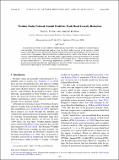Weather radar network benefit model for flash flood casualty reduction
Author(s)
Cho, John Y.; Kurdzo, James M.
Downloadjamc-d-19-0176.1.pdf (1.678Mb)
Publisher Policy
Publisher Policy
Article is made available in accordance with the publisher's policy and may be subject to US copyright law. Please refer to the publisher's site for terms of use.
Terms of use
Metadata
Show full item recordAbstract
A monetized flash flood casualty reduction benefit model is constructed for application to meteorological radar networks. Geospatial regression analyses show that better radar coverage of the causative rainfall improves flash flood warning performance. Enhanced flash flood warning performance is shown to decrease casualty rates. Consequently, these two effects in combination allow a model to be formed that links radar coverage to flash flood casualty rates. When this model is applied to the present-day contiguous U.S. weather radar network, results yield a flash flood–based benefit of $316 million (M) yr−1. The remaining benefit pools are more modest ($13 M yr−1 for coverage improvement and $69 M yr−1 maximum for all areas of radar quantitative precipitation estimation improvements), indicative of the existing weather radar network’s effectiveness in supporting the flash flood warning decision process. ©2020 Keywords: radars/radar observations; regression analysis; economic value; flood events; geographic information systems (gis); societal impacts
Date issued
2020-03Department
Lincoln LaboratoryJournal
Journal of applied meteorology and climatology
Publisher
American Meteorological Society
Citation
Cho, John Y.N. and James M. Kurdzo, "Weather radar network benefit model for flash flood casualty reduction." Journal of applied meteorology and climatology 59, 4 (March 2020): p. 589-604 doi 10.1175/JAMC-D-19-0176.1 ©2020 Author(s)
Version: Final published version
ISSN
1558-84322
1558-8424